Mollies is a small group of live-bearing fish of the Poecilia genus (earlier, they were included with Mollienesia genus). They are rather popular and undemanding aquarium fish that even beginner aquarists can deal with. Due to selective breeding programs, many new variations were obtained, with different coloring and body shapes. They are all widespread and renowned tank dwellers, though quite often, they look very different. This is all due to their peacefulness, endurance, unpretentiousness, inexpensiveness, and easy breeding. Molly fish differ only in size and color, but the info about breeding, keeping, compatibility is the same for all of them.
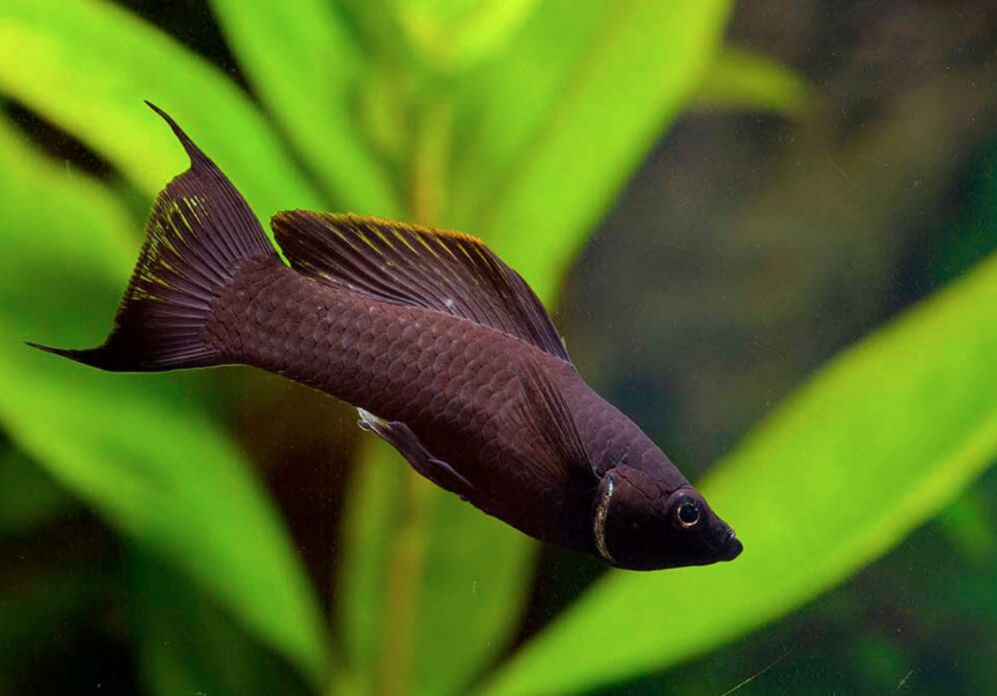
Contents
Difficulties in keeping
Molly fish are well-known for their peaceful nature, colorful appearance, and live-bearing reproductive system. They are a popular choice for community aquariums due to their ease of care and compatibility with other peaceful fish species. Molly fish come in various color variations, and their striking appearance makes them attractive to aquarium hobbyists.
The fishes are easy to care for and keep. They are a good choice for beginner aquarists. This is especially true for well-known and widespread black molly. You should be careful only with a balloon molly fish since, due to its curved shape, its lifespan is shorter than that of other molly species.
Q&A
Where are mollies from?
Molly fish (Poecilia species) are native to various countries in Central and South America. Their natural distribution ranges from southern Mexico to parts of Central America, including Belize, Guatemala, Honduras, Nicaragua, Costa Rica, and Panama. They can be found in various freshwater habitats, including rivers, streams, ponds, marshes, and brackish waters near coastal areas.
Are molly fish aggressive?
Molly fish are generally considered peaceful and not aggressive. They are community-friendly fish that can coexist peacefully with a variety of other peaceful fish species.
Can molly fish live alone?
Molly fish are social creatures, and they generally thrive in the company of their own species or other peaceful community fish. While they can survive and live alone in an aquarium, keeping a single molly fish without any companions is not ideal for their well-being.
How big do mollies get?
The size of mollies can vary depending on the species and the conditions they are kept in. In general, mollies are small to medium-sized fish. Here are some common types of mollies and their average sizes:
- Common Molly (Poecilia sphenops): Common mollies usually grow to be around 2.5 to 4 inches (6.5 to 10 cm) in length.
- Sailfin Molly (Poecilia latipinna): Sailfin mollies can grow slightly larger than common mollies, reaching lengths of 4 to 5 inches (10 to 12.5 cm).
- Yucatan molly (Poecilia velifera): This is the largest molly, and its size may be up to 10 cm (4 in) large, while in the wild, it is up to 6 inches (15 cm).
It’s important to note that the size of mollies can also be influenced by factors such as their diet, water quality, and the size of the aquarium they are kept in. Providing a well-maintained and appropriately sized tank with a balanced diet can help ensure healthy growth and longevity for your mollies.
How long do molly fish live?
The lifespan of molly fish can vary depending on various factors, including their species, genetics, water quality, diet, and overall care. In general, molly fish have an average lifespan of about 2 to 5 years. It depends on the living environment and tank water temperature. The higher is the temperature, the faster is the metabolism and the lifespan decreases. However, provided with proper tank conditions, molly can live long and give birth to several fish generations during this time.
How to tell the age of a molly fish?
Determining the exact age of a molly fish can be challenging, as there are no specific external markers that directly indicate their age. Unlike some animals, mollies do not have growth rings or other easily identifiable age-related features. However, there are a few general indicators that can give you an idea of whether a molly fish is young or mature:
- Size: Young mollies are generally smaller than mature adults. As mollies grow, they develop from tiny fry into larger juveniles and eventually reach their full adult size. By comparing their size to typical adult measurements for their species, you can estimate if they are still growing or have reached their full size.
- Coloration: In some species or varieties of mollies, the color patterns may change as they age. Young mollies may have less intense coloration, and their colors may become more vibrant as they mature.
- Sexual Maturity: Maturity and readiness for breeding can also give an indication of age. Female mollies are sexually mature around 3-4 months of age, while males may mature slightly earlier. If your molly fish are actively breeding, they are likely sexually mature adults.
History
Molly fish belong to the Poeciliidae family, which is a family of freshwater fish found in Central and South America. The scientific name of the most commonly kept molly fish is Poecilia sphenops. The Poeciliidae family includes various other popular aquarium fish such as guppies (Poecilia reticulata), platies (Xiphophorus maculatus), and swordtails (Xiphophorus hellerii).
Poecilia sphenops have become the first described molly species. The description ws made by a French zoologist Achille Valenciennes in 1846 while working on his 22 books of “Histoire Naturelle des Poissons” (Natural History of Fish).
More than 50 years later, a renowned ichthyologist-classifier Charles Tate Regan described Poecilia salvatoris and Poecilia velifera basing on the sample study results in the British Natural History Museum.
In 1913 Poecilia latipinna was brought to Europe.
Since 1920 active work on selective breeding has started, and various hybrids appeared one after another. This was promoted by, first of all, the possibility of breeding between the three main molly kinds: Poecilia sphenops, Poecilia latipinna, and Poecilia velifera.
Habitat in the wild
Did you know that the molly genus (in Latin – Mollienesia) was abolished, and now all fishes from it are included in the livebearers genus (in Latin Poecilia). Well, I didn’t. I have found it only when preparing this article. And the fact that various fishes that we know as molly fishes are now also in this genus only adds more confusion.
Habitat is rather diversified – freshwater, brackish, saline water of different temperatures, hardness, and acidity. Various Poecilia fishes have some differences in their morphological characters. They’ve got used to different life conditions.
Wild molly kinds inhabit both freshwater and brackish waters through quite a wide territory. Its North border includes the South of Texas, while the southern border stretches along the Caribbean side of Colombia and Venezuela. Such a large habitat, including areas with quite different natural conditions, suggests the presence of many local forms of the kind which natural coloring essentially varies depending on the habitat.
As a result of the introduction, you can encounter the fish even on the other continents where they live and breed in conditions similar to their original ones. Thus, nowadays, there are local populations in Singapore, Japan, and some other places on our planet.
Sphenops molly fish is encountered in Mexico and Colombia waters, and sailfin molly can be found in channels with brackish water in Carolina state, Texas, Virginia, and Florida; yucatan molly can be seen only in Mexican peninsula Yucatan.
Keeping in a tank
Tank size
The tank size for molly fish depends on the specific type of molly, the number of fish you plan to keep, and whether you want to include other fish species in the aquarium. Generally, molly fish are active swimmers and can grow to around 2.5 to 4 inches (6.5 to 10 cm) in length, so they require adequate space to thrive.
In my opinion minimum tank size for the successful keeping of a small group of molly fish (3 to 5 individuals) is about 20 gallons (75 liters). This provides enough swimming space and allows you to maintain stable water conditions.
But these are active fishes. A 30-gallon (113 liters) or 40-gallon (150 liters) tank would be more suitable in such cases. Don’t keep the fish in small and crowded tanks. They may grow to become 10 cm long and will not feel comfortable in a small volume tank.
It’s important to remember that a larger tank usually means better water quality and more stable conditions, which can lead to healthier and happier fish. Overcrowding can cause stress and lead to health issues, so it’s best to avoid keeping molly fish in tanks that are too small for their needs.
For yucatan molly, it’s better to select a twice larger tank since they are significantly larger than their relatives. They like swimming a lot, and for this reason, it is recommended to get a tank of classical rectangular shape with a lid: molly often jumps out from the water.
Water parameters
Mollies are quite enduring fish, and they can adapt to a wide range of water parameters. Yet, it is desirable to create optimal conditions in a tank. There should be a stable biotic balance in a tank.While they are relatively adaptable, it’s essential to keep the water conditions within suitable ranges to ensure their optimal growth and longevity.
Here are the recommended water parameters for molly fish:
- Temperature: All molly fishes are quite thermophilic, and they prefer a water temperature of about 72°F to 82°F (22°C to 28°C). They don’t stand rapid temperature changes.
- pH Level: 7.5 to 8.5 – Molly fish thrive in slightly alkaline water. Keeping the pH within this range is beneficial for their overall health and well-being.
- Ammonia (NH3/NH4+): 0 ppm – Ammonia is toxic to fish, including molly fish. It’s crucial to ensure that ammonia levels remain at 0 ppm to prevent harm to the fish.
- Nitrite (NO2-): 0 ppm – Like ammonia, nitrite is harmful to fish. Regular water changes and proper filtration are essential for keeping nitrite levels at 0 ppm.
- Nitrate (NO3-): Below 40 ppm – Nitrates are less toxic than ammonia and nitrite, but high levels can still be harmful. Regular water changes help control nitrate levels in the aquarium.
- General Hardness (GH): 10 to 25 dGH – Molly fish prefer moderately hard water, and maintaining GH within this range is beneficial for their health.
- Carbonate Hardness (KH): 10 to 25 dKH – Keeping KH within the recommended range helps stabilize the pH and prevent rapid fluctuations.
- Water renew – Just like all other fishes, molly fish likes clear water. That’s why it’s desirable to renew water systematically. Once a week, perform water renewal in the volume of ¼ from the whole tank capacity. This will ensure the absence of nitrogenous compounds of high concentration in the tank, such as ammonia, nitrites, and nitrates.
Water salinity
We should also mention that molly fish can live in brackish water as well, and in some resources, they even recommend putting some salt into the tank water intentionally. Well, this will not harm the fish, but don’t forget that this fish quite seldom inhabits without any tank mates, and the latter may not stand brackish water, or it could even be toxic for them. Therefore, I’d recommend adding some salt into the tank only if molly fish live alone or when they are in quarantine.
Filtration and aeration
Water filtration and aeration are required. Water filtration is a crucial aspect of maintaining a healthy and clean environment for molly fish in the aquarium. Proper filtration helps remove waste, toxins, and impurities from the water, ensuring that the water quality remains suitable for the well-being of the fish.
When choosing a filter for a molly fish tank, consider the tank size, the number of fish, and the level of waste they produce. Generally, a filter that can handle at least 4-6 times the tank volume per hour is recommended for optimal water quality.
Regular maintenance of the filter is essential to ensure it functions efficiently. This includes cleaning or replacing filter media, rinsing off debris, and regularly monitoring water parameters.
Remember that molly fish produce more waste than some other species, so investing in a good filtration system will help maintain a clean and healthy aquarium for your fish.
Plants and decorations
Most of the time, the fish spends in upper and middle water layers. You also have to create open and well-lighted areas in the tank. Snags, stones, lots of plants should be present in the tank and provide the fish with some shelter if needed.
Black mollies are very useful in planted tanks because without damaging the plants. They keep them clean by eating algae from their leaves.
Mollies feel quite good in tanks with live plants. It’d be good to organize some thickly planted areas in the tank, but don’t forget to leave some free space for the fish to swim.
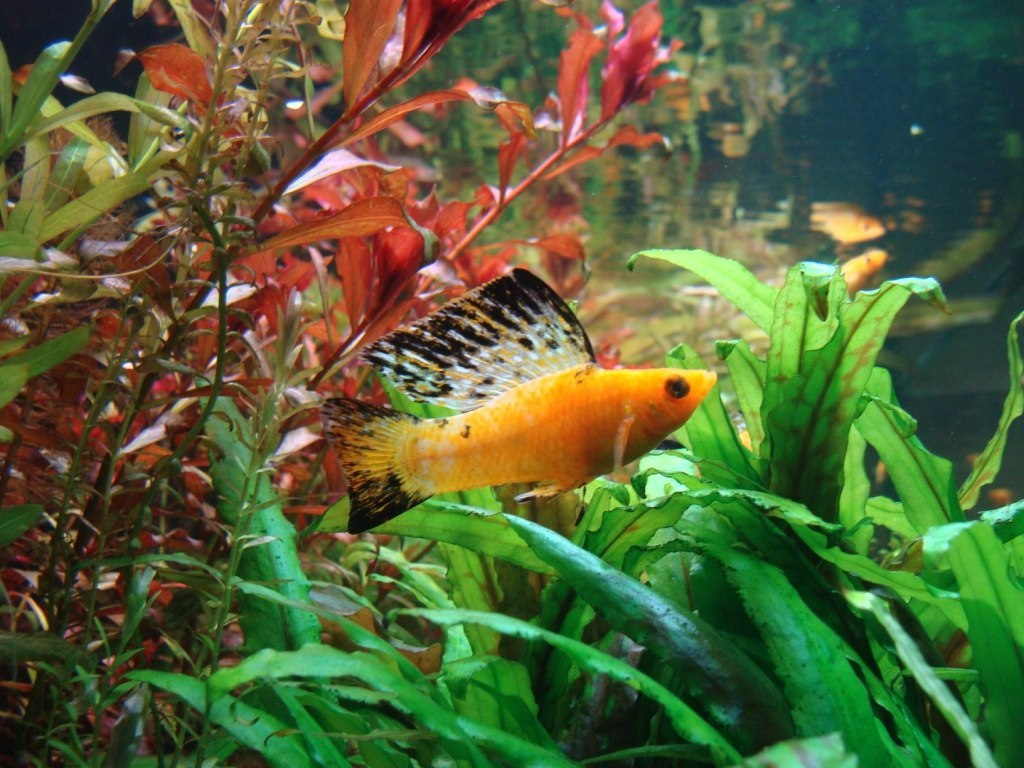
Tank mates
Molly fish is a very active one, and it is considered a peaceful one, though I’d rather say that it is a moderately aggressive one. Yes, in a roomy tank, it behaves very peaceful and calmly, but if the tank is small and crowded, the fish can show aggression towards its kind and sometimes to other fishes in the tank.
It’s better to keep back molly fish in a group where females prevail. This is a common rule for all live-breeders since when the number of males is equal to or higher than that of the female fish, the latter will always be stressed due to the males haunting them all the time.
The fish can live both in a common tank and separately. It gets on well with various tank mates. In general, tank mates have to be approximate of a similar size. Molly fish have good relationships within their group – they almost don’t show any intraspecific aggression. But at the same time, if the tank is small, the males may haunt each other. That’s why it’s better to have a spacious tank so that at least 2 gallons (10 liters) of water would fall for one fish.
When selecting tank mates, let them be of a similar size. Mollies get on well with other live-bearing fishes such as (guppy, Endler’s guppy, platy, swordtail), characins (black neon tetra, cardinal tetra, ember tetra, flame tetra, neon tetra), rasboras (harlequin rasbora), danios (zebrafish), corydoras (Corydoras julii, panda cory, pygmy cory, Adolfo’s catfish), plecos (bristlenose pleco). They can live together with barbs (tiger barb, cherry barb, Odessa barb, rosy barb); Poecilia velifera is the only exception – the males’ long fins may be nipped in this case. When keeping mollies with other fishes, the tank should be spacious, and it should have enough shelters. It’s not recommended to keep even large molly species with aggressive cichlids (like Jack Dempsey fish, jaguar cichlid, texas cichlid, flowerhorn).
If you want all mollies in the tank to have the same appearance, don’t keep different fish kinds together in the tank to avoid cross-breeding.
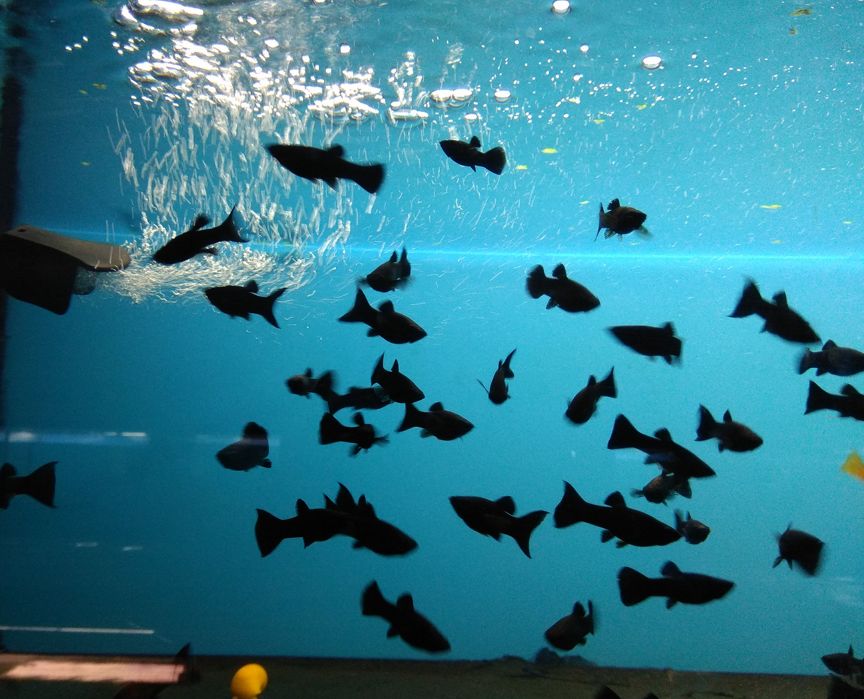
Diet
This is an omnivorous fish that eats all types of live, frozen, or artificial food. However, molly fish needs a large amount of food with vegetable fibers component, for example, with algae or vegetables. In the wild, molly fish has lots of algae in its diet. You can see it from the fish lips and behavior. You can often see how it scrapes algae and fouling from tank glass and decorations.
As for the fish food with vegetable components, it’s better to feed molly fish with molly flakes, or you can give it pieces of boiled cucumbers, squash, lettuce leaves. Live food you may add to the fish diet is bloodworm, tubifex, brine shrimp. In general, feeding molly fish isn’t complicated. The main thing is to remember that the vegetable component is very important in the fish diet.
Feeding them with quality artificial food is the best option since this food is well-balanced, has all necessary vitamins, and digest well. Such food is easier to serve and store.
You should feed them several times a day. The food portion should be enough to be eaten by the fish in several minutes. We should mention that mollies are prone to overeating, so the food portions must be small.
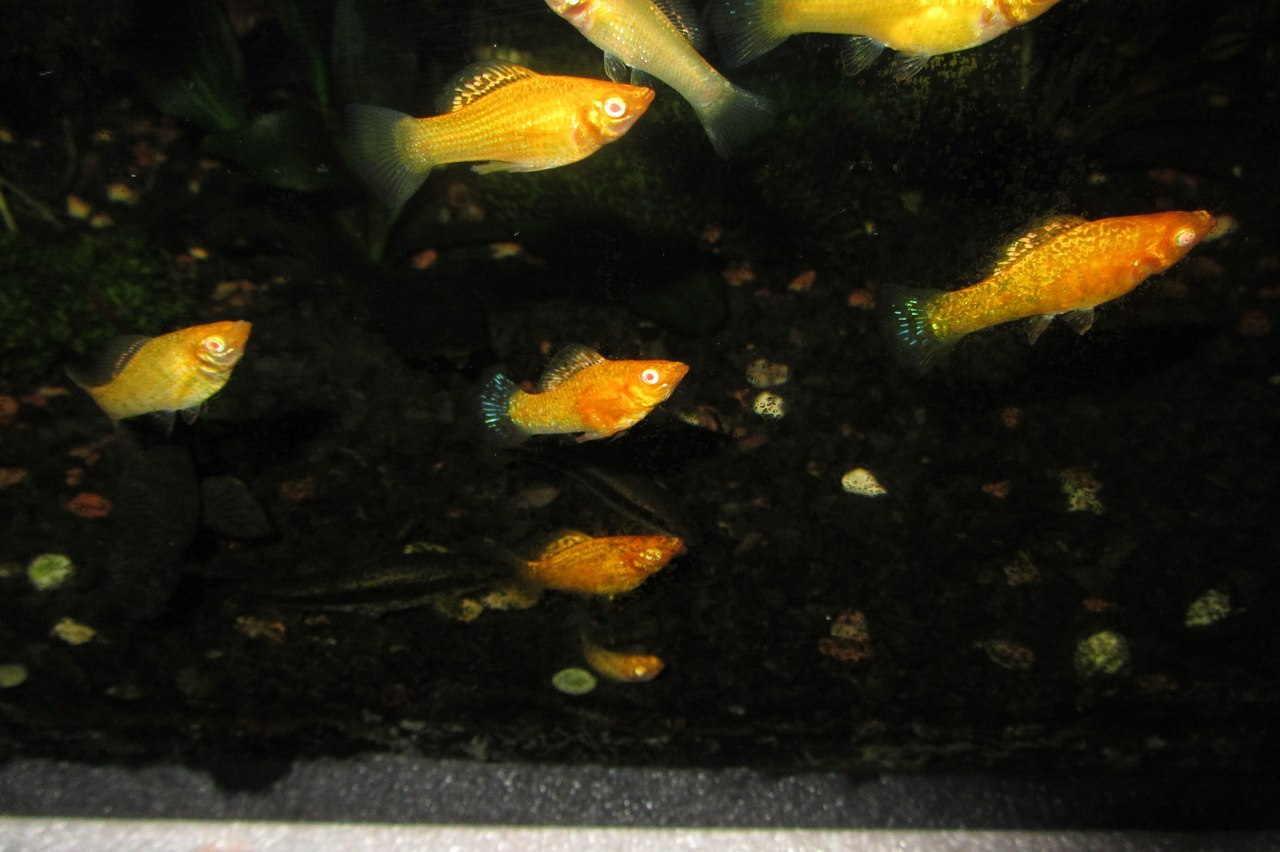
Gender differences: male vs female
It is quite simple to see between the male and female fish. Male and female molly fish can be distinguished by several physical and behavioral differences.
Here are some of the key characteristics that can help you identify male and female mollies:
- Size: In general, male molly fish are slightly smaller than females. Females tend to be larger and more robust, especially when they are pregnant with fry (baby fish).
- Fin Shape: One of the most noticeable differences is in the shape of their anal fin, located on the underside of the fish near the tail. Male mollies have a modified anal fin called a “gonopodium,” which is elongated and pointed. The gonopodium is used for mating and is absent in females.
- Pregnancy: Female molly fish have a prominent gravid spot near their anal fin. This spot is darker in color and becomes more pronounced as the female carries developing fry. Female mollies are livebearers, meaning they give birth to live, fully-formed fry rather than laying eggs.
- Behavior: Male mollies tend to exhibit more active and aggressive behavior, especially during mating and when competing for the attention of females. They may chase females and other males during courtship.
- Body Shape: Female molly fish often have a rounder abdomen, especially when carrying fry. In contrast, male mollies may have a more streamlined body shape.
- Coloration: While there is no specific rule for color differences between male and female mollies, some species and varieties may exhibit sexually dimorphic color patterns. For example, male mollies of certain varieties might have more vibrant and colorful markings compared to females.
Keep in mind that these differences may vary slightly depending on the species and variety of molly fish you have. Additionally, it might be easier to distinguish male and female mollies once they reach sexual maturity, which usually occurs around 3-4 months of age.
Breeding
Molly fish is a live-breeder just like a guppy, which means that the juveniles are spawned into the tank is completely formed, and they skip the egg stage. You don’t need any special conditions for breeding. It’s quite enough to keep males and females together in a common tank.
Provided with comfortable tank conditions, molly fish spawns every month. When mating, the male fish uses its gonopodium, which has a tube to transfer ejaculate to the male fish, and hooks closer to the female when fertilizing her, which increases chances of successful fertilization. The fish males become reproductive at about 12 months, and females when being 6 months old.
Mollies can breed both in community tanks and in a separate spawning tank. However, the latter is more preferable because tank mates in the community tank may eat the juveniles. The female ready for spawning should be put in a tank of at least 5 liters capacity. In large tanks, the fish will be too stressed. Put some shelters and plants into the spawning tank, and they will become shelters for the offspring. Sadly, parents can eat their juveniles as well.
The female fish carries eggs for about 35 – 45 days. It’s difficult to see if the female fish is pregnant, especially in black molly fish.
As for the pregnancy signs – they are the enlarged abdomen, and the female fish starts to look for shelter in some dark corners of the tank. It’s desirable to put such a female fish into a separate spawning tank where water parameters will be the same as that of the common tank.
Usually, spawning occurs in the early morning. Large-sized female fish may spawn up to a hundred juveniles at once. The number depends on female fish age and size. Molly fish juveniles are born rather large. They don’t get up from the tank bottom right away and stay there or on the leaves of tank plants for a while. Molly fish juveniles are very sensitive to tank water contamination. That’s why it’s recommended to renew the water in the tank with juveniles more often than usual.
To grow fast, the juveniles need to have a diversified diet. They are fed with milled high-quality artificial food or special food for fry.
Molly fish types
There are four mollies fish kinds in the wild:
- Short-finned molly or common molly (Poecilia sphenops)
- Liberty molly (Poecilia salvatoris)
- Yucatan molly (Poecilia velifera)
- Sailfin molly (Poecilia latipinna)
All other fish variations with different body and fins shape and coloring are selective breeds obtained as a result of cross-breeding within the four basic kinds.
| Scientific Name | Poecilia, early Mollienesia |
| Family | Poeciliidae |
| Common Name | Molly, molly fish, black molly fish |
| Ease of keeping | Easy |
| Lifespan | 5 years and more |
| Tank size | 50 liters (13 US gallons) and more |
| Temperament | Peaceful |
| Tank type | Community of fishes |
| Diet | Omnivorous |
| Temperature | 77-80,6 ºF (25-27 °C) |
| pH | 7.0-8.0 |
| Water hardness | 10–20 dGH |
| Size | about 4-5 inches large (12.5 cm) |
Molly Natural breeds
Common molly (Poecilia sphenops)
This is the fish that black molly, the most popular tank fish, derived from. Nowadays, natural fish coloring isn’t almost encountered in aquariums since the wild species has less bright coloring, unlike its black variation. Its body is greyish-green on top with a slight light-blue tint, the body bottom is lighter, and the color varies from gray-white to silvery-blue. Dark spots of different color intensity are scattered over the fish body.
Poecilia sphenops have elongated, solid, and flattened from sides body with a round well-developed tail fin. The fins are small. Its mouth is meant for eating food from the water surface and algae scraping. The body size varies from 2 to 4 inches (5-10 cm). The females are larger than males.
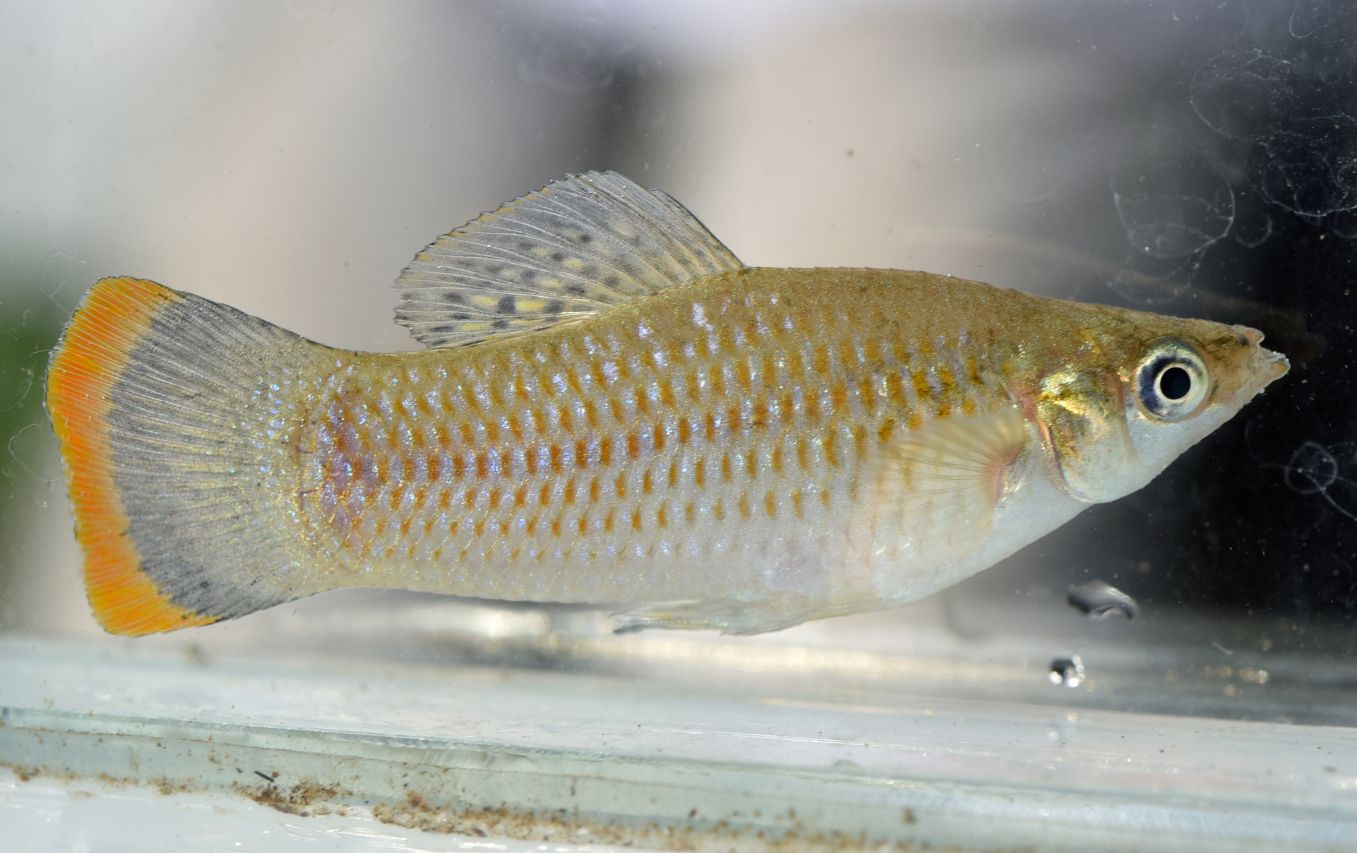
| Characteristic | Description |
|---|---|
| Scientific Name | Poecilia sphenops |
| Family | Poeciliidae |
| Origin | Central and South America |
| Size | 2.5 to 4 inches (6 to 10 cm) |
| Lifespan | 2 to 5 years |
| Colors | Various colors and patterns (black, white, orange) |
| Temperament | Peaceful and social |
| Aquarium Size | At least 10 gallons (38 liters) per fish |
| Water Parameters | Temperature: 72-82°F (22-28°C), pH: 7.0-8.5 |
| Diet | Omnivorous – flake/pellet food, live/frozen foods |
| Breeding | Livebearers – females give birth to live fry |
| Compatibility | Get along with other peaceful community fish |
| Tank Setup | Plenty of hiding spots and live plants |
| Care Level | Easy |
| Maintenance | Regular water changes and tank cleaning |
| Special Considerations | Sensitive to water quality, avoid aggressive tankmates |
Yucatan molly (Poecilia velifera)
A distinctive feature of this kind is a well-developed dorsal of the male species. The fin size may be up to 3 inches (4-5 cm) large and take most of the fish back. This is the largest molly, and its size may be up to 10 cm (4 in) large, while in the wild, it is up to 6 inches (15 cm). The tail fin has a rounded shape. The natural body color is silvery with horizontal dashed lines.
Due to its size, the fish requires spacious tanks. It is very active and needs space to swim. Also, be attentive when choosing its tank mates. Some fishes, such as tiger barbs, may nip molly’s fins.
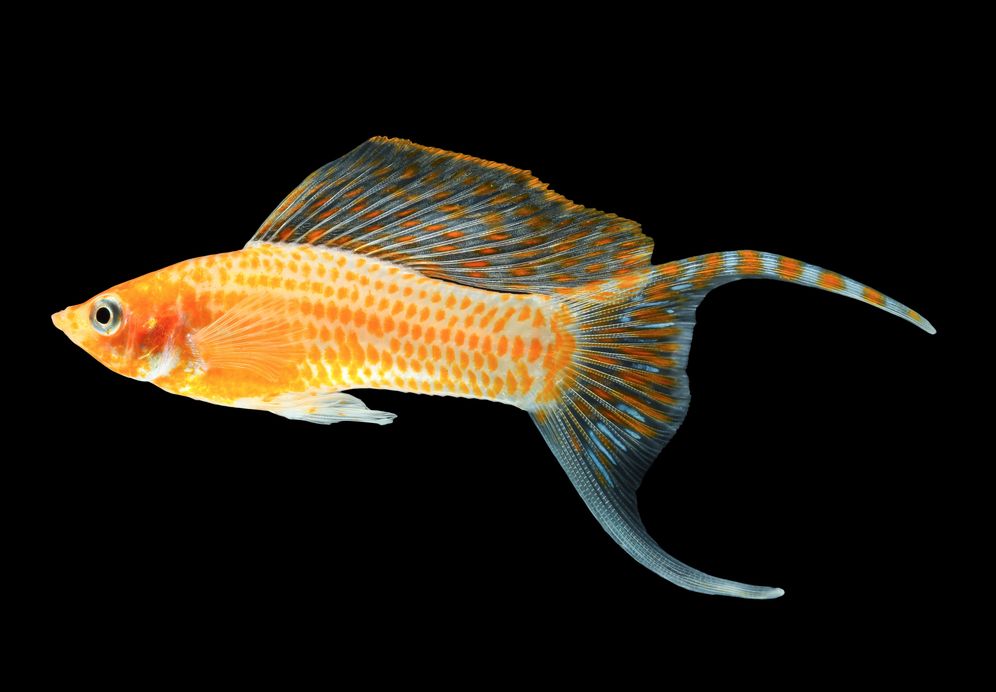
| Characteristic | Description |
|---|---|
| Scientific Name | Poecilia velifera |
| Common Name | Yucatan Molly |
| Origin | Mexico, specifically the Yucatan Peninsula |
| Size | Typically 3 to 4 inches (7.5 to 10 cm) |
| Lifespan | 2 to 5 years |
| Temperament | Peaceful and social |
| Water Conditions | Freshwater with a temperature of 72-82°F (22-28°C) |
| Tank Size | Minimum 20 gallons (75 liters) for a small group |
| Diet | Omnivorous – eats flakes, pellets, and live foods |
| Tank Level | Middle and top of the aquarium |
| Gender Differences | Males are smaller and more colorful than females |
| Breeding | Livebearer – gives birth to live fry |
| Special Considerations | Prefers planted tanks with hiding spots |
Sailfin molly (Poecilia latipinna)
It is very similar to yucatan molly but smaller, and it has different coloring. The body is tall, elongated, solid, and flattened from sides. The dorsal is high and rectangular in shape, and it has 12-14 rays. The tail fin is round and well-developed.
In the wild, males’ size is up to 5 in (12 cm). However, usually, males in size are up to 3 in (7.5 cm), while mature females are up to 2.5 in (6.5 cm). The coloring, in general, is bluish-grey. Males coloring has a green-blue tint with sparkling white spots on their sides that create rows. The body bottom is bright orange. The fins are blue with orange edges, colorful spots, and dashes.
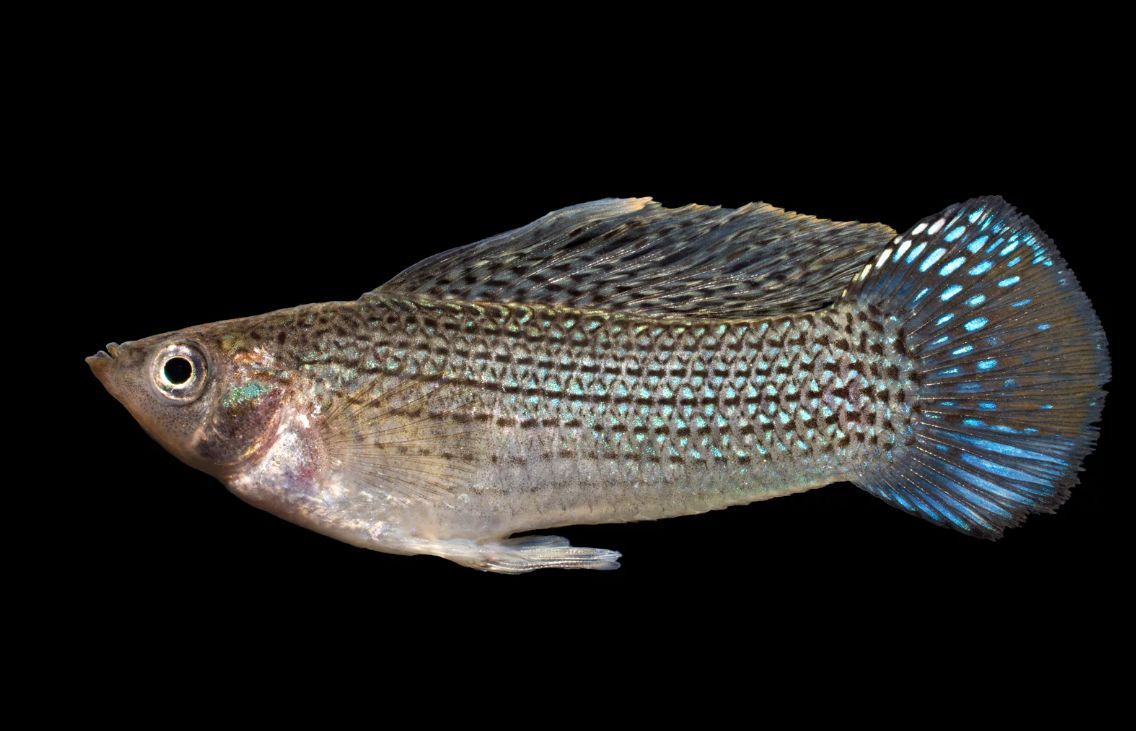
| Characteristic | Description |
|---|---|
| Scientific Name | Poecilia latipinna |
| Common Name | Sailfin Molly |
| Family | Poeciliidae |
| Origin | Coastal regions of North, Central, and South America |
| Size | Up to 4 inches (10 cm) |
| Lifespan | 2 to 5 years |
| Colors | Various colors, including black, white, orange, yellow, and silver |
| Body Shape | Elongated and laterally compressed |
| Dorsal Fin | Large, sail-like dorsal fin |
| Behavior | Peaceful and social |
| Water Conditions | Tropical freshwater |
| Temperature Range | 72°F to 82°F (22°C to 28°C) |
| pH Range | 7.0 to 8.5 |
| Tank Size | Minimum 20 gallons for a small group |
| Diet | Omnivorous – eats both plants and small insects |
| Feeding | Flakes, pellets, and small live/frozen foods |
| Compatibility | Generally peaceful, but avoid aggressive tankmates |
| Breeding | Livebearer – gives birth to live fry |
| Special Considerations | Males have more prominent fins than females |
Liberty molly (Poecilia salvatoris)
For a long time, this fish has been considered a Poecilia sphenops’ variation, but currently, it has become a separate kind. It inhabits El Salvador waters. It can be quite seldom seen in tanks, even though it has an appealing coloring. Partially, this is due to its aggressive temper — the fish attacks both its relatives and other tank dwellers. Its body is silvery-yellow. It may have some light-blue tint. The abdomen and dorsal fins are very bright (red, black, or white).
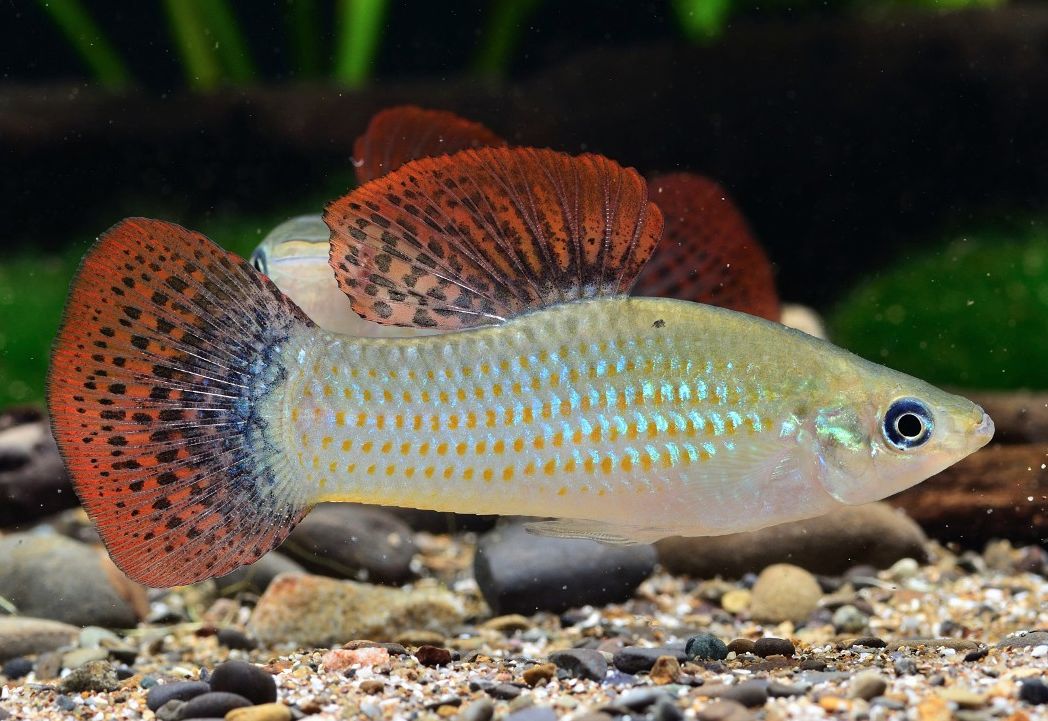
Molly selective breeds
Selectionists constantly strive to create more and more new color variations of tank fish. They even conduct genetic experiments (for example, glofish). The same has happened to molly since this is a live-bearing fish which offspring is easy to get.
Black molly fish
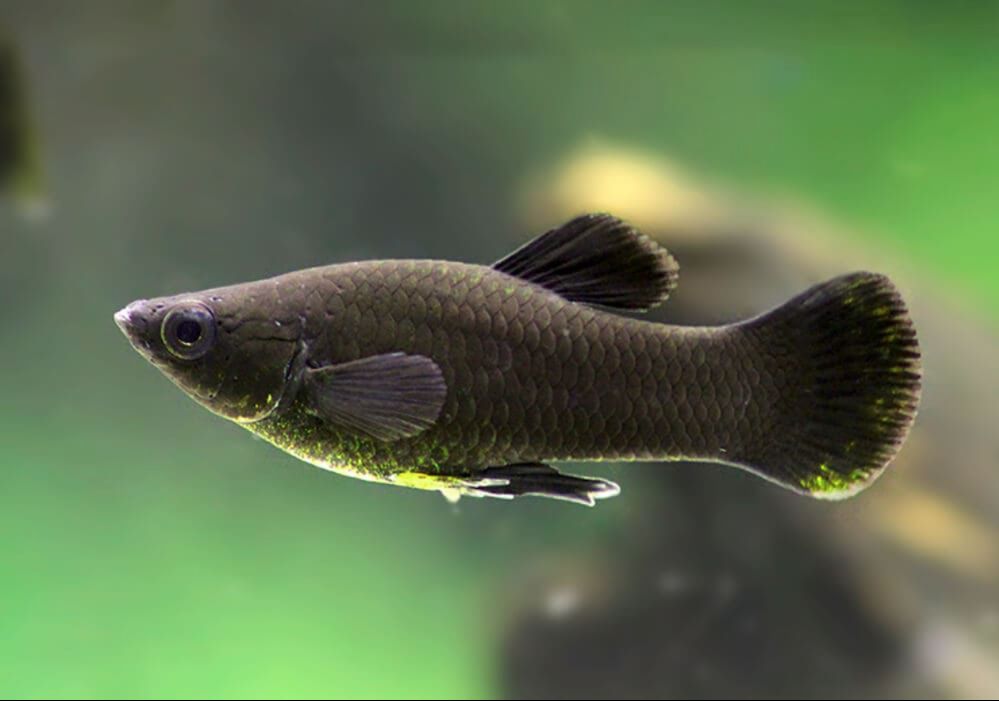
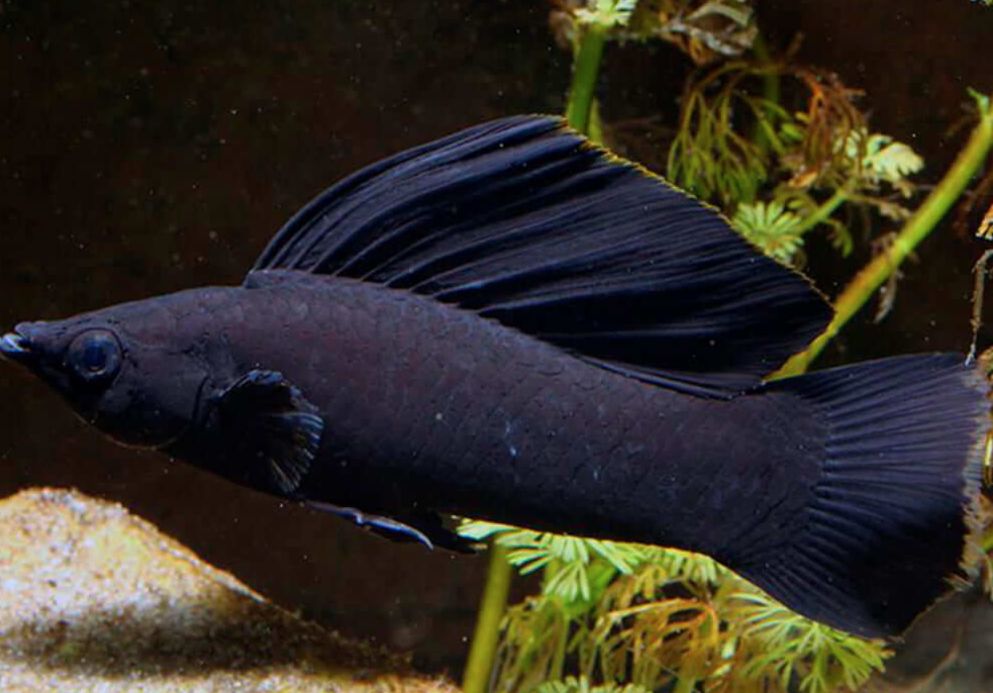
This is the most famous, popular, and undemanding fish among all mollies. This fish is the best choice for beginner aquarists – black molly fish. It is less demanding, easier to breed, and requires a smaller tank capacity. In general, in this article, we’ll talk about black molly fish, though almost all we say is true for the other species.
The fish has an elongated body and a bit flattened from the sides. Its eyes and upward mouth are relatively large. The male fish grows up to 3 inches long (6–7.5 cm), and the female is about 4 inches large (10 cm) at the age of about 6 months. The beautiful fish fins get their maximum beauty and size only during the 2nd year of the fish life. Reference samples of black molly fish don’t have any glitter or spots on their body – they are coal-black.
Due to its coloring, black molly has been popular for many years.
In the wild, species with such coloring don’t exist. This color variation was obtained in the USA at the end of the 20s in the XX century. Sometime later, in Singapore, as a result of hybridization, lyretail mollies were obtained.
Black lyretail molly fish
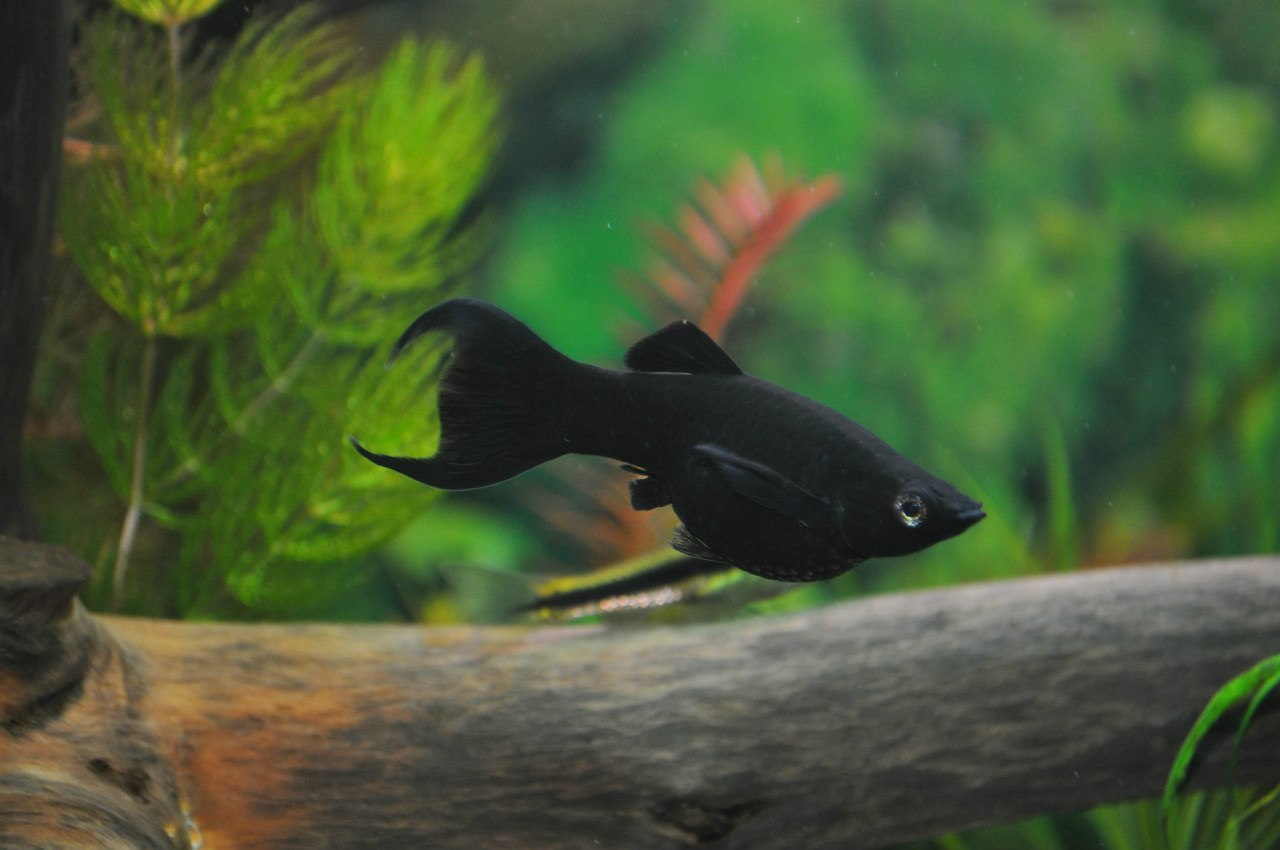

These fishes with a lyre-shaped tail are also in great request. Their main distinctive feature is their tail fin structure. Its edge rays are longer than others, and they form a curve resembling an ancient musical instrument – a lyre. The coloring may vary. A huge number of color variations were bred, and none of them can be considered as the basic one.
In the process of hybridization with closely related species, such species as Poecilia sphenops and Poecilia velifera have also obtained a lyre-shaped tail. That’s why curren
Gold dust molly fish
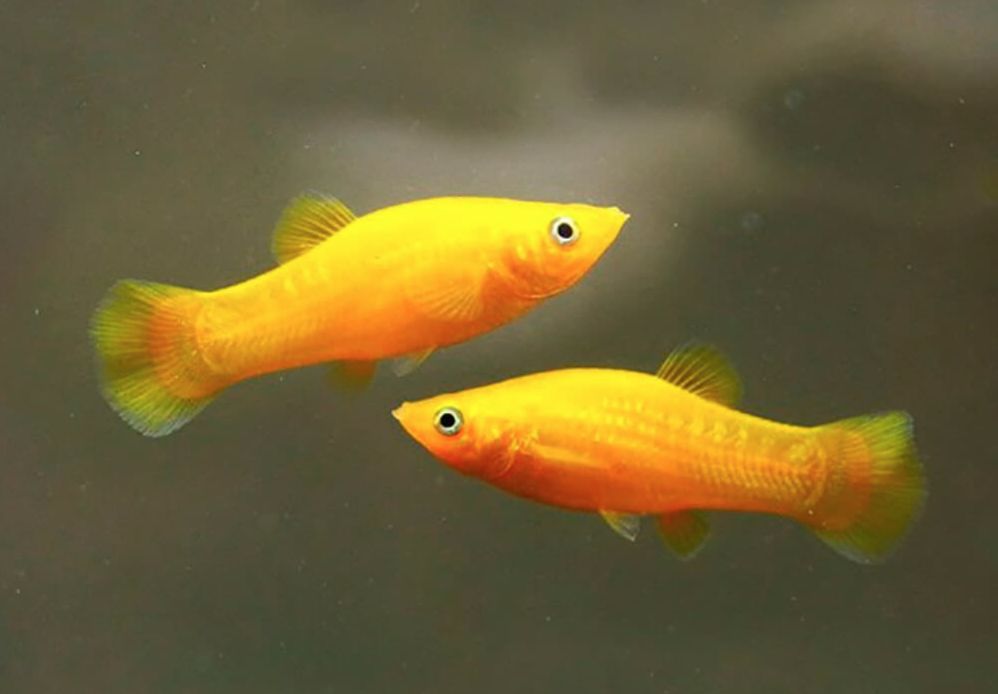
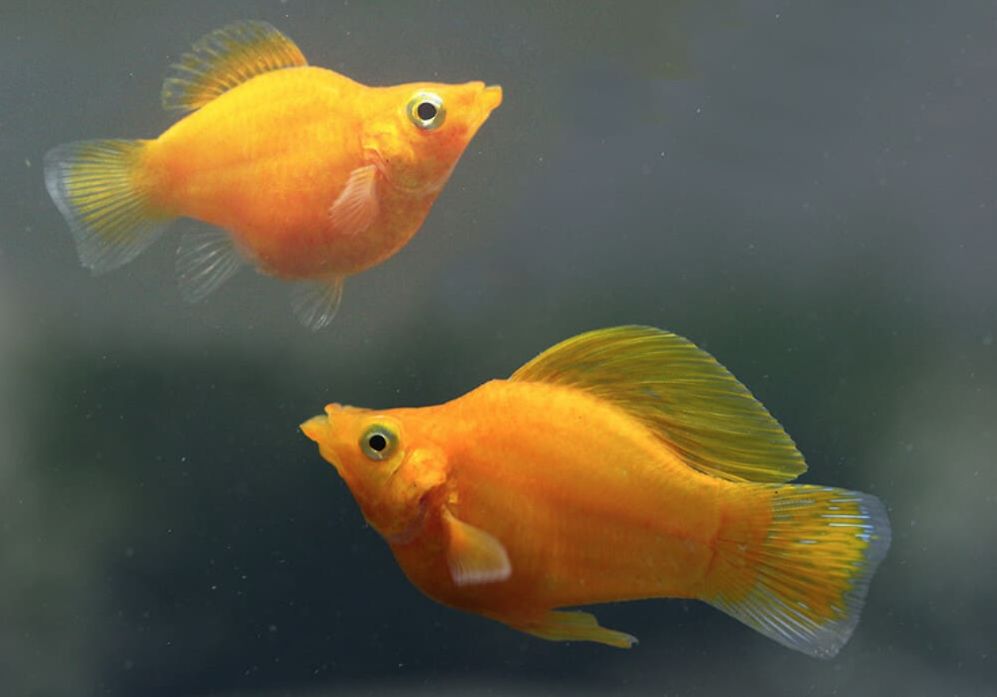
Golden molly fish is a tank fish with yellow-orange body coloring prevailing. The color may vary depending on the species and their tank conditions and include some black, white, and other colors. Tank conditions and care are the same as for any other molly. They are undemanding that can dwell in a wide variety of water parameters.
White molly fish
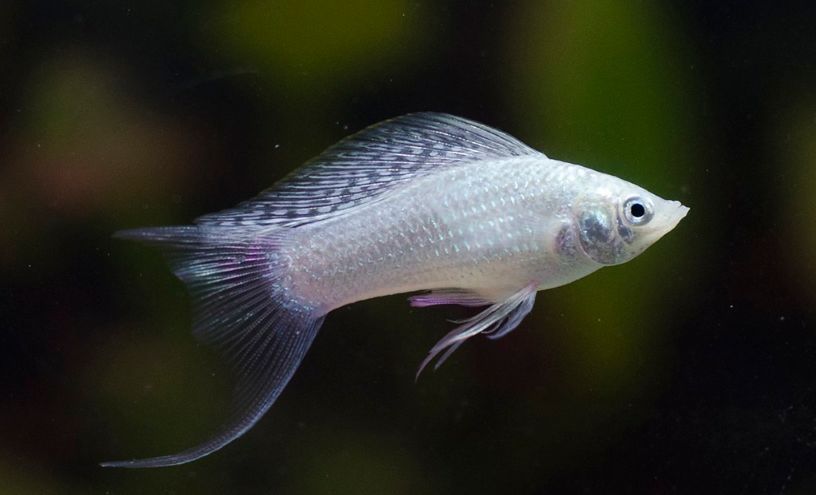
This is a generic term, and it is equally applicable to selective variations Poecilia velifera or Poecilia latipinna, as well as towards their hybrids. It is not encountered in the wild, and it was bred artificially. The main feature of the fish is its uniform silvery body coloring. The fins are semi-transparent with white speckles. Depending on the specific kind (Latipinna or Velifera), the adult species size will vary. The males are larger than females and have a large dorsal resembling a flag or a sail.
Dalmatian molly fish
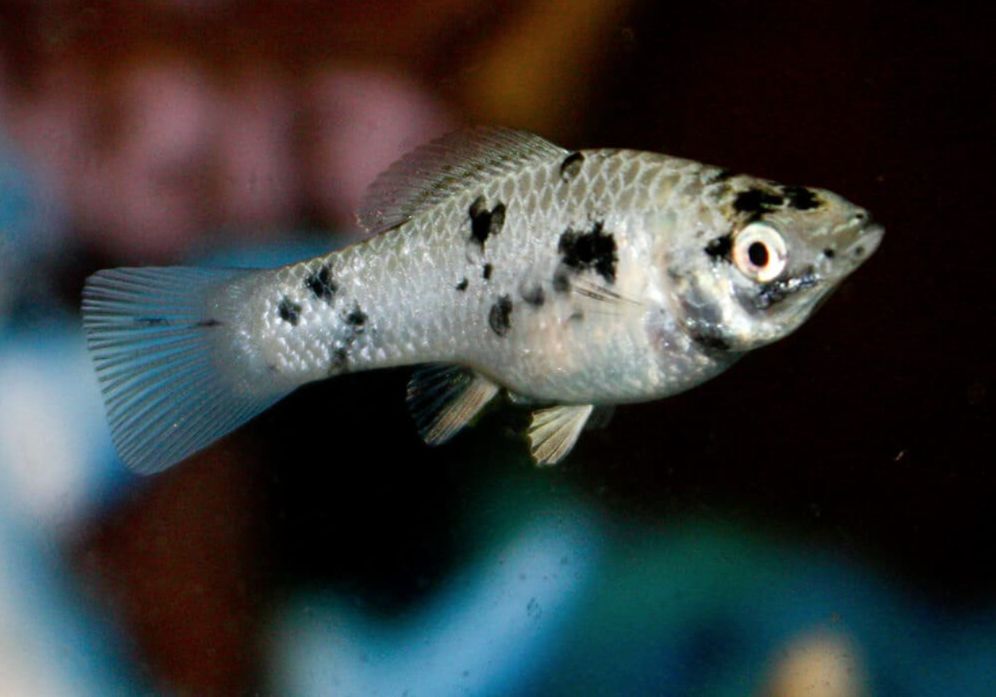
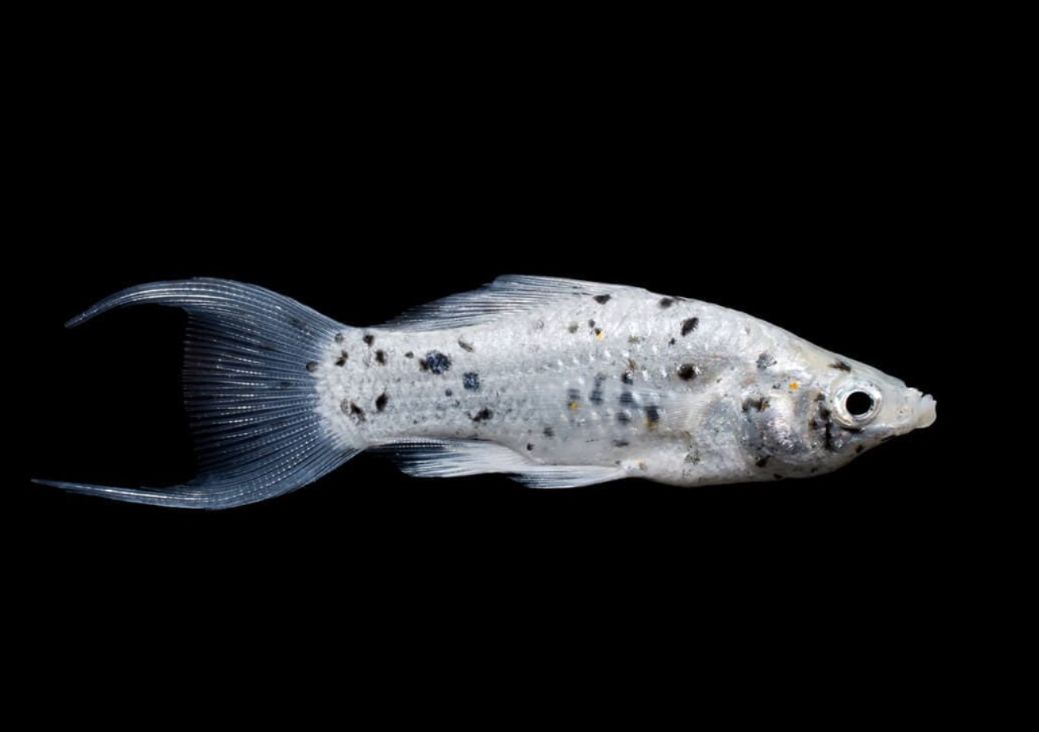
This is black and white molly fish, which is an artificially bred color variation, and it’s not encountered in the wild. It has a unique body pattern – black spots and speckles on a white background that resemble the dalmatian dog’s color patterns. It is supposed that the variation was obtained based on the spotted Poecilia latipinna species.
Balloon molly fish
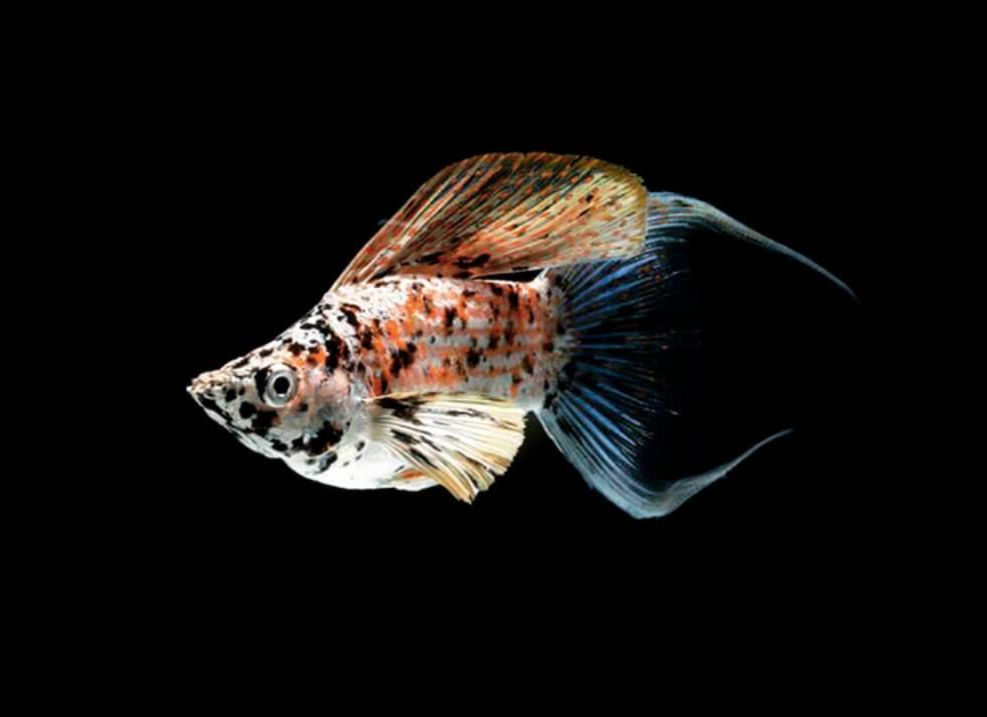
A shortened body and a large abdomen characterize it. The body coloring may be different: orange, white, red, black.This is the weakest molly since its innards are lessened and pressed. The fish, as a rule, is more demanding to tank conditions (due to their curved spine), and their lifespan is seldom longer than 1.5-2 years. Nevertheless, these bright, barrel-like fishes can variegate your tank and are quite popular.
Gold Panda Molly fish
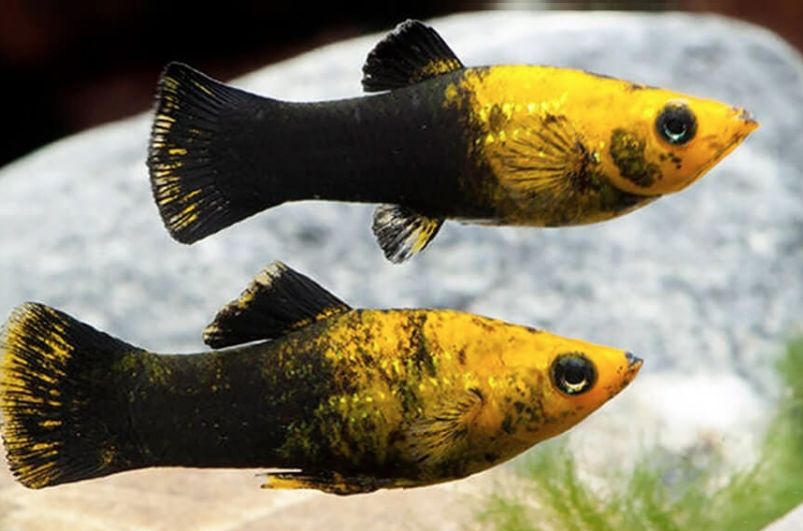
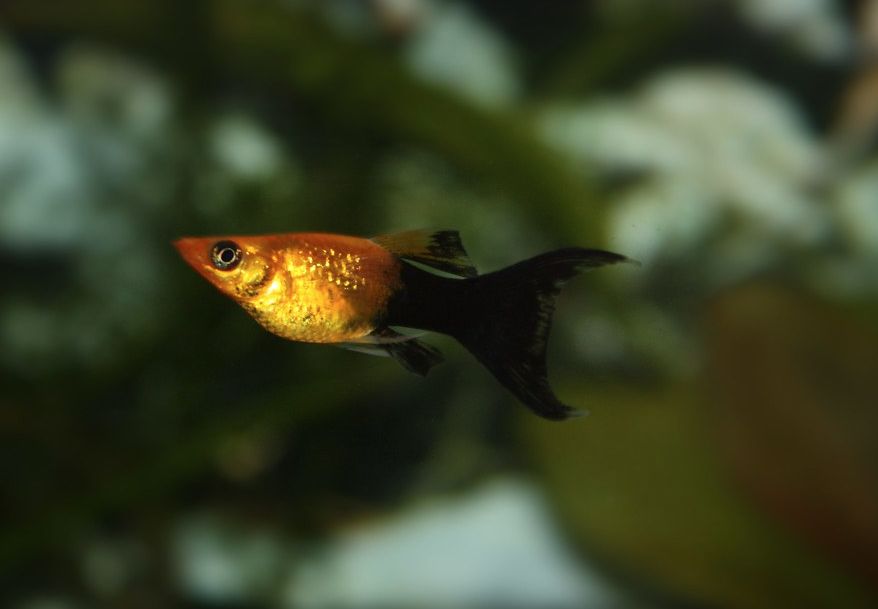
This is a selective breed and quite a rare one. Intense yellow coloring merges into black near the fish’s tail. It has black eyes. The breed name has become a collective one and is equally used for all mollies with a similar tail fin structure.